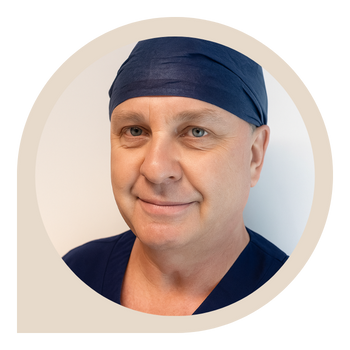Dr. Mark Irving
Wisdom Teeth Removal
When there isn’t enough room, wisdom teeth can get stuck under the gum, only come through partway, or grow at an angle that pushes against other teeth. This can sometimes lead to soreness, swelling, or infections, and over time, it might even affect your other teeth. Even if you’re not experiencing major problems now, removing them early can help prevent more significant issues in the future, such as pain or damage to healthy teeth nearby.
Why is it done?
Wisdom teeth, also known as third molars, are the last set of permanent teeth to emerge in the mouth, typically surfacing between the ages of 17 and 25. In some individuals, these teeth may come through the gums fully, while in others, they may emerge partially or not at all. There are cases where wisdom teeth do not appear at all.
For many people, the eruption of wisdom teeth does not cause any complications. However, a significant number of individuals experience impacted wisdom teeth. This condition occurs when there is insufficient space in the mouth for the teeth to come through properly.
Impacted wisdom teeth can grow in various ways, including:
Angling towards the adjacent second molar
Angling towards the back of the mouth
Growing at a right angle to the other teeth, resembling a "lying down" position within the jawbone
Erupting straight up or down like the other teeth but remaining trapped within the jawbone
Understanding these patterns of emergence can help in making informed decisions regarding dental care and treatment options for wisdom teeth.
Our Approach
Wisdom teeth removal services are available to patients across Sydney, including Parramatta and surrounding areas. If you’re experiencing discomfort or have been advised to have your wisdom teeth assessed or removed, contact us today to arrange a consultation with Dr Mark Irving.
Step 1
Consultation and Assessment
Book an appointment with us, and we will assess your wisdom teeth using a clinical examination and X-rays to determine if removal is necessary and to plan the procedure.
Step 2
Procedure and Recovery
The removal is typically performed as a day surgery under general anaesthesia. After the teeth are extracted, you’ll receive detailed aftercare instructions to help manage discomfort and promote healing.
Step 3
Follow-Up and Healing
Attend your scheduled follow-up appointment to ensure your mouth is healing well and to address any concerns. Most patients return to normal activities within a few days, provided they follow proper oral care and the surgeon’s advice.
After wisdom teeth removal?
Do’s
Rest for the first 24–48 hours and avoid strenuous activity.
Keep your head elevated to help reduce swelling.
Apply ice packs on the outside of your cheek intermittently for the first day.
Stick to soft, cool foods like yoghurt, smoothies, and soups.
Take any prescribed medication as directed.
Gently rinse your mouth with salt water from day two onwards.
Don’t’s
Don’t smoke, vape, or use straws for at least 72 hours (these can dislodge the blood clot and lead to a dry socket).
Avoid spitting forcefully or rinsing your mouth vigorously on the first day.
Don’t eat hard, crunchy, or spicy foods until you’re fully healed.
Don’t touch the extraction site with your fingers or tongue.
Key areas of Wisdom Teeth removal include:
Wisdom teeth, also known as third molars, are typically the last teeth to develop and emerge, usually appearing between the ages of 17 and 25. For many young people, there is insufficient space in the jaw for these teeth to present correctly. As a result, wisdom teeth may become impacted (trapped beneath the gum), partially erupted, or grow at an awkward angle.
When there is not enough space, these teeth can sometimes cause soreness, swelling, or infection. In some cases, impacted wisdom teeth can push against neighbouring teeth, leading to crowding or damage. Even if there are no noticeable symptoms at first, dental specialists often recommend removing wisdom teeth to prevent future problems, such as pain, infection, or complications that may affect other teeth.
The removal of wisdom teeth is a common and well-understood procedure. Dr Mark Irving and his team are experienced in supporting young patients through each stage, ensuring comfort, safety, and a clear understanding of what to expect.
Common Signs and Symptoms
Many people experience discomfort or notice changes in their mouth when wisdom teeth begin to cause trouble. Common symptoms include jaw pain, swelling, tenderness, difficulty opening the mouth, or an unpleasant taste caused by infection. Some patients develop gum inflammation or repeated infections around partially erupted wisdom teeth. If left untreated, these symptoms can worsen and negatively impact your overall oral health, making timely assessment and removal crucial.
The Assessment and Planning Process
Before any removal, Dr Mark Irving conducts a thorough consultation, including a clinical examination and dental X-rays. This helps to determine the position of your wisdom teeth, their roots, and any risk factors unique to your situation. Dr Irving will explain your options for anaesthesia (local, sedation, or general), answer any questions you may have, and develop a tailored plan to ensure a safe and comfortable experience from start to finish.
The Wisdom Teeth Removal Procedure
Wisdom teeth removal is typically performed as a day surgery. Depending on the complexity and your comfort preferences, the procedure can be done under local anaesthesia, IV sedation, or general anaesthesia. Dr Irving uses modern, gentle techniques to remove the teeth efficiently while minimising trauma to surrounding tissues. You’ll be given clear aftercare instructions to manage any swelling, discomfort, or bleeding, helping you to recover as quickly as possible.
Recovery and Aftercare
Within a few days. You’ll be provided with detailed guidance on caring for your mouth during the healing process, including what to eat, how to keep the area clean, and signs of any potential complications. Dr Irving’s team is always available to answer questions or address concerns during your recovery, ensuring you feel supported at every stage.
Commonly Asked Questions about Wisdom Teeth Removal
How painful is wisdom tooth removal?
Wisdom tooth removal is a standard procedure, and I take every measure to ensure your comfort throughout the process. During surgery, you’ll be under local anaesthetic (or sedation if required), so you won’t feel pain while I’m working. After the anaesthetic wears off, some discomfort and swelling are normal for a few days. Most people describe the pain as manageable with the help of prescribed or over-the-counter pain relief. If you follow the post-operative instructions carefully, you’ll recover faster and with fewer complications. If your pain seems severe or lasts longer than expected, don’t hesitate to get in touch—your well-being is my priority.
Why are dentists reluctant to remove wisdom teeth?
Dentists may be cautious about removing wisdom teeth for several reasons. Not all wisdom teeth need to come out—if they’re healthy, fully erupted, and easy to clean, removal isn’t always necessary. However, if a tooth is impacted, infected, or likely to cause future problems, removal is often the best choice. Some extractions can be complex due to the position of the tooth or proximity to nerves and sinuses, so your dentist may refer you to a specialist like myself for your safety. My role is to carefully assess your situation and recommend the option with the lowest risk and best long-term outcome.
Why is day 3 the worst after wisdom teeth removal?
It’s very common for patients to report that day three is the most uncomfortable. This is because the initial swelling and inflammation from the procedure tend to peak around the third day. The body’s natural healing response ramps up, leading to more swelling, stiffness, and sometimes increased pain compared to the first two days. Rest assured, this is normal and typically starts improving by day four or five. Staying on top of your pain relief and following my care instructions (like using ice packs, keeping your head elevated, and sticking to soft foods) will make this phase easier to manage.
What are the disadvantages of removing wisdom teeth?
While wisdom tooth removal is generally safe and often necessary, as with any surgical procedure, there are potential disadvantages and risks. These may include temporary discomfort, swelling, bruising, or limited mouth opening during the recovery period. In rare cases, complications such as infection, dry socket (where the blood clot is dislodged), nerve injury leading to numbness, or sinus issues (if upper teeth are involved) can occur. I always weigh up the risks and benefits before recommending surgery. My approach is to minimise these risks through careful planning and clear aftercare guidance. Ultimately, if removal is advised, it’s because the long-term benefits for your oral health outweigh the potential downsides.
Post-Op Care
Please use the following information as a general guideline. If you have any concerns after surgery, please get in touch with Dr. Irving's office at (02) 9890 1822.
Important
You should reach out to your surgeon, general practitioner, or the nearest accident and emergency department if you experience any of the following issues:
Severe pain that is not relieved by the recommended medication
Ongoing bleeding
Any other significant problems following the operation




